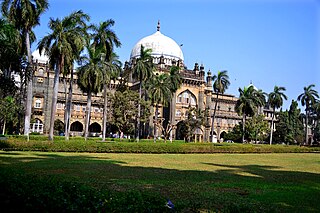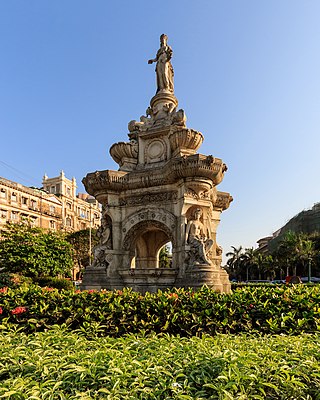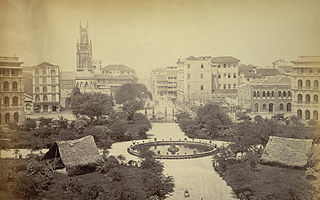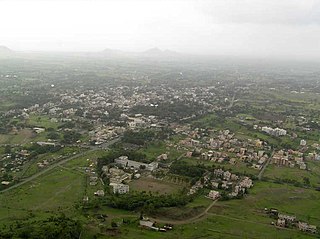
Indian architecture is rooted in the history, culture, and religion of India. Among several architectural styles and traditions, the best-known include the many varieties of Hindu temple architecture and Indo-Islamic architecture, especially Rajput architecture, Mughal architecture, South Indian architecture, and Indo-Saracenic architecture. Early Indian architecture was made from wood, which did not survive due to rotting and instability in the structures. Instead, the earliest existing architecture are made with Indian rock-cut architecture, including many Buddhist, Hindu, and Jain temples.

Chhatrapati Shivaji Terminus (officially Chhatrapati Shivaji Maharaj Terminus since 2017, formerly Victoria Terminus (VT), Bombay station code: CSMT (mainline)/ST (suburban)), is a historic railway terminus and UNESCO World Heritage Site in Mumbai, Maharashtra, India.

Chhatrapati Shivaji Maharaj Vastu Sangrahalaya, (CSMVS) formerly named the Prince of Wales Museum of Western India, is a museum in Mumbai (Bombay) which documents the history of India from prehistoric to modern times.

Victorian architecture is a series of architectural revival styles in the mid-to-late 19th century. Victorian refers to the reign of Queen Victoria (1837–1901), called the Victorian era, during which period the styles known as Victorian were used in construction. However, many elements of what is typically termed "Victorian" architecture did not become popular until later in Victoria's reign, roughly from 1850 and later. The styles often included interpretations and eclectic revivals of historic styles (see Historicism). The name represents the British and French custom of naming architectural styles for a reigning monarch. Within this naming and classification scheme, it followed Georgian architecture and later Regency architecture and was succeeded by Edwardian architecture.

Flora Fountain is a Fountain located at the Hutatma Chowk is an ornamentally sculpted architectural heritage monument located at the southern end of the historic Dadabhai Naoroji Road, at the Fort business district in the heart of South Mumbai, Mumbai, India. Flora Fountain, built in 1864, depicts the Roman goddess Flora. It was built at a total cost of Rs. 47,000, or 9,000 pounds sterling, a large sum in those days.

The Horniman Circle Gardens is a large park in South Mumbai, Maharashtra, India, which encompasses an area of 1.01 hectares. It is situated in the Fort district of Mumbai, and is surrounded by office complexes housing the country's premier banks. Designed to be a large open space with grand buildings in the middle of the walled city, the area had been known as Bombay Green in the 18th century, later Elphinstone Circle. Following India's independence in 1947, the area was renamed in honour of Benjamin Horniman, editor of The Bombay Chronicle newspaper, who supported Indian independence.

TheAsiatic Society of Mumbai is a learned society in the field of Asian studies based in Mumbai, India. It can trace its origin to the Literary Society of Bombay which first met in Mumbai on 26 November 1804, and was founded by Sir James Mackintosh. It was formed with the intention of "promoting useful knowledge, particularly such as is now immediately connected with India". After the Royal Asiatic Society of Great Britain and Ireland was established in London in 1823, the Literary Society of Bombay became affiliated with it and was known as the Bombay Branch of the Royal Asiatic Society (BBRAS) since 1830. The Bombay Geographical Society merged with it in 1873, followed by the Anthropological Society of Bombay in 1896. In 1954, it was separated from the Royal Asiatic Society and renamed the Asiatic Society of Bombay. In 2002, it acquired its present name. It is funded by an annual grant from the Central Government of India.

A chaitya, chaitya hall, chaitya-griha, refers to a shrine, sanctuary, temple or prayer hall in Indian religions. The term is most common in Buddhism, where it refers to a space with a stupa and a rounded apse at the end opposite the entrance, and a high roof with a rounded profile. Strictly speaking, the chaitya is the stupa itself, and the Indian buildings are chaitya halls, but this distinction is often not observed. Outside India, the term is used by Buddhists for local styles of small stupa-like monuments in Nepal, Cambodia, Indonesia and elsewhere. In Thailand a stupa, not a stupa hall, is called a chedi. In the historical texts of Jainism and Hinduism, including those relating to architecture, chaitya refers to a temple, sanctuary or any sacred monument.

Elphinstone College is one of the constituent colleges of Dr. Homi Bhabha State University, a state cluster university. Established in 1856, it is one of the oldest colleges in Mumbai. It played a major role in shaping and developing the educational landscape of the city. It also played a pivotal role in the inception of the University of Mumbai.

Junnar is a city in the Pune district of the Indian state of Maharashtra. The city has history dating back to the first millennium. The nearby fort of Shivneri was the birthplace of Maratha king Shivaji, the founder of the Maratha Empire. Junnar was declared the first tourism taluka in Pune district by the government of Maharashtra on 9 January 2018.

Chennai architecture is a confluence of many architectural styles. From ancient Tamil temples built by the Pallavas, to the Indo-Saracenic style of the colonial era, to 20th-century steel and chrome of skyscrapers. Chennai has a colonial core in the port area, surrounded by progressively newer areas as one travels away from the port, punctuated with old temples, churches and mosques.

The David Sassoon Library and Reading Room is a famous library and heritage structure in Mumbai, India. The idea for a library to be situated in the center of the city came from Albert Sassoon, son of the famous Baghdadi Jewish philanthropist, David Sassoon.

The Municipal Corporation Building, Mumbai, located in South Mumbai, Maharashtra, India is a Grade IIA heritage building opposite to the Chhatrapati Shivaji Terminus at the junction of Dadabhai Naoroji Road and Mahapalika Marg. It is also known as the BrihanMumbai Municipal Corporation Building, or BMC building for short.

The Global Vipassana Pagoda is a Meditation dome hall with a capacity to seat around 8,000 Vipassana meditators near Gorai, in the north western part of Mumbai, Maharashtra, India. The Global Vipassana Pagoda is declared as one of the "One of Seven Wonders of Maharashtra" by Maharashtra Tourism Development Corporation (MTDC) in partnership with ABP Majha, a Marathi news channel; after they reviewed 350 destinations. The results of this selection were declared on 6th June 2013. The pagoda was inaugurated by Pratibha Patil, then President of India, on 8 February 2009. It is built on donated land on a peninsula between Gorai creek and the Arabian Sea. The pagoda is to serve as a monument of peace and harmony. The Global Vipassana Pagoda has been built out of gratitude to Sayagyi U Ba Khin, Vipassana teacher and the first Accountant-General of Independent Burma, who was instrumental in Vipassana returning to India, the country of its origin.
The architecture of Mumbai blends Gothic, Victorian, Art Deco, Indo-Saracenic & Contemporary architectural styles. Many buildings, structures and historical monuments remain from the colonial era. Mumbai, after Miami, has the second largest number of Art Deco buildings in the world.

Maharashtra state in India is known for its Famous caves and cliffs. It is said that the varieties found in Maharashtra are wider than the caves and rock-cut architecture found in the rock cut areas of Egypt, Assyria, Persia and Greece. The Buddhist monks first started these caves in the 2nd century BC, in search of serene and peaceful environment for meditation, and they found these caves on the hillsides.

Many heritage structures are found in Mumbai, India.

The Art Deco in Mumbai, India style is a notable feature of the architecture of the city. It was used primarily for office buildings, residences and movie theaters, during a period when India was part of the British Empire. On 30 June 2018, an ensemble of such buildings were officially recognized as a World Heritage site by the UNESCO World Heritage committee held in Bahrain as the Victorian and Art Deco Ensemble of Mumbai.

Maharashtra Police Headquarters building is a Grade I listed UNESCO World Heritage Site in South Mumbai that was built between 1872 and 1876, and designed by the British architect Frederick William Stevens, who also designed the Chhatrapati Shivaji Maharaj Terminus. The building is often confused with Mumbai Police Headquarters, also built in Gothic Revival style, and several newspapers often carry the image of Maharashtra headquarters while reporting on the latter. The headquarters are located at Wellington Circle in Fort, and face the Wellington Fountain.
























